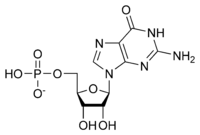User:Blandine Velut/Sandbox
From Proteopedia
| Line 32: | Line 32: | ||
The second dimerization sub-domain, D2 (residues 579-693) is similar to D1 sub-domain and they are superposed. This leads also to the D2 sub-domain to be superposed on the ATPPase sub-domain allowing the formation of the XMP active site in the synthetase domain. | The second dimerization sub-domain, D2 (residues 579-693) is similar to D1 sub-domain and they are superposed. This leads also to the D2 sub-domain to be superposed on the ATPPase sub-domain allowing the formation of the XMP active site in the synthetase domain. | ||
| - | + | <scene name='75/750228/Active_site/1'>The active site</scene> is located between the ATPPase sub-domain and the D2 sub-domain. When XMP is bound to it, it is allostericly regulated and covered by a lid motif (residues 368-408) closing in over the active site. Thus, the XMP is wedged between a Pro-rich region (residues 438–441) and a loop (residues 383–385). | |
The synthetase domain binds several cofactors. Indeed, <scene name='75/750228/Sulfate/1'>three sulphate ions</scene> are bound to the ATPPase and D2 sub-domains. There are also Mg2+ and ATP which can bind. | The synthetase domain binds several cofactors. Indeed, <scene name='75/750228/Sulfate/1'>three sulphate ions</scene> are bound to the ATPPase and D2 sub-domains. There are also Mg2+ and ATP which can bind. | ||
Revision as of 20:00, 26 January 2017
2vxo
HUMAN GMP SYNTHETASE
An ample supply of nucleotides is essential for many life processes, including cell maturation, cell division and transmission of the genetic information. Indeed, nucleotides are the activated precursors of nucleic acids, but they also are major energy carriers, and precursors for the synthesis of nucleotide cofactors. Among these molecules is the guanosine monophosphate (GMP), also known as 5'-guanidylic acid or guanylic acid, a nucleotide that is used as a monomer in RNA. Like other nucleotides, GMP can be synthesized by 2 main pathways : de novo pathway and salvage pathway. De novo synthesis of nucleotide involves several enzymatic reaction and enzymes. Here, we will focus on the final step of the process, which is catalyzed by a glutamine amidotransferase called GMP synthetase (GMPS; E.C. 6.3.5.2). This enzyme belongs to the family of ligases, and catalyzes the conversion of xanthine monophosphate (XMP) to GMP in the presence of glutamine and ATP. [1]
| |||||||||||
References
- ↑ Oliver JC, Linger RS, Chittur SV, Davisson VJ. Substrate activation and conformational dynamics of guanosine 5'-monophosphate synthetase. Biochemistry. 2013 Aug 6;52(31):5225-35. doi: 10.1021/bi3017075. Epub 2013 Jul, 23. PMID:23841499 doi:http://dx.doi.org/10.1021/bi3017075
- ↑ http://www.uniprot.org/uniprot/P49915
- ↑ http://www.uniprot.org/uniprot/P49915


